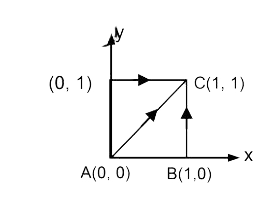A body of mass 1kg begins to move under the action of a time dependent force →F=(2tˆI+3t2ˆj)N, where ˆi and ˆj are unit vectors along x-and y-axes. What power will be developed by the force at the time t ?
A
(2t2+4t4)W
B
(2t3+3t4)W
C
(2t3+3t5)W
D
(2t+3t3)W
Video Solution
Text Solution
The correct Answer is:C
(C ) According to question, a body of mass 1 kg begins to move under the action of time dependent force,
F=(2tˆi+3t2ˆj)N
mdvdt=2tˆi+3t2ˆj
∫dv=∫(2tˆi+3t2ˆj)dt
v=t2ˆi+t3ˆj
∴ Power developed by the force at the time t will be given as
P=F.v=(2tˆi+3t3ˆj).(t2ˆi+t3ˆj)=(2t.t2+3t2.t3) lt P=(2t3+3t5)W
|
Updated on:21/07/2023
Topper's Solved these Questions
- BOOK - DC PANDEYCHAPTER - WORK, ENERGY AND POWEREXERCISE - MATCH THE COLUMNS7videos
WORK, ENERGY AND POWER
- BOOK - DC PANDEYCHAPTER - WORK, ENERGY & POWEREXERCISE - Level 2 Comprehension Based2videos
WORK, ENERGY & POWER
- BOOK - DC PANDEYCHAPTER - WORK, POWER AND ENERGYEXERCISE - E Integer Type Questions11videos
WORK, POWER AND ENERGY
Similar Questions
Knowledge Check
- Question 1 - Select One
A body of mass 1 kg begins to move under the action of a time dependent force F=(2tˆi+3t2ˆj)N,whereˆiandˆj are unit vector along x and y axis. What power will be developed by the force at the time?
A(2t3+3t4)WB(2t3+3t5)WC(2t2+3t2)WD(2t2+3t4)W - Question 2 - Select One
A body of mass 1kg begins to move under the action of a time dependent force →F=(2tˆi+3t2ˆj)N, where ˆi and ˆj are unit vectors along X and Y axis. What does will be developed by the source at time t ?
A(2t2+4r4)WB(2t2+3r4)WC(2t3+3r5)WD(2t+3r3)W - Question 3 - Select One
The angle which the vector →A=2ˆi+3ˆj makes with the y-axis, where ˆi and ˆj are unit vectors along x- and y-axis, respectively, is
Acos−1(3/5)Bcos−1(2/3)Ctan^(-1)(2//3)Dsin−1(2/3)
A body of mass 0.5 kg initially at rest is accelerating , due to a time dependent force [¯¯¯F={tˆi+√tˆj}] N then instantaneous power developed due to this force at t = 3 s will be
View SolutionIf ˆiandˆj are unit vectors along X- and Y-axis respectively, then what is the magnitude and direction of ˆi+ˆjandˆi−ˆj ?
View SolutionThe unit vector along →A=2ˆi+3ˆj is :
View SolutionA particle of mass m moves from A to C under the action of force →F=2xyˆi+y2ˆj , along different paths as shown in figure.
 View Solution
View SolutionAn object of mass 2 kg at rest at origin starts moving under the action of a force
→F=(3t2ˆi+4tˆj)N The velocity of the object at t = 2 s will be -View Solution

